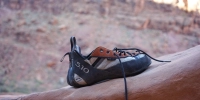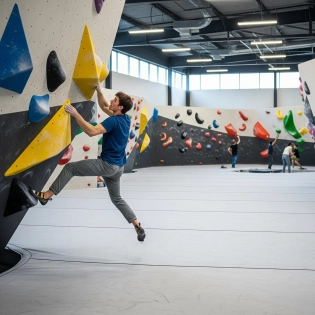







Climbers Point
Yes, you can absolutely rock climb if you are overweight. Climbing is a sport that welcomes individuals of all shapes and sizes. While being overweight might present certain challenges, it doesn't mean you can't participate and enjoy the sport.
Rock climbing can actually be a great activity for individuals who are overweight, as it offers a full-body workout and helps build strength, endurance, and flexibility. It can be a fun and engaging way to improve your overall fitness and work towards your personal climbing goals.
As with any physical activity, it's important to listen to your body, start at a comfortable level, and progress gradually. Focus on developing good technique, using your body efficiently, and finding routes that suit your current fitness level. Remember to consult with a climbing instructor or guide who can provide guidance specific to your needs.
Rock climbing is a sport that celebrates the accomplishments of all climbers, regardless of their weight or body type. Enjoy the process, challenge yourself, and have fun on the wall!
Best way to break in your shoes is to use them, this includes the heels and any other part of the shoe. Some areas might break in faster based on use, such as if you do a lot of heel hooks then the heel area of the shoe might break in faster.
Best bet is to climb in them as much as you can, just like breaking in the shoes in general, and to try and incorporate more heel hooks and heel specific movements. Either way, the heel will break in along with the rest of the shoe with more usage.
Rock climbers develop a ripped physique because the sport engages multiple muscle groups in the body. Climbing requires significant upper body and grip strength, which leads to muscular development in the arms, shoulders, and back. The constant use of core muscles for stability and leg muscles for propulsion also contributes to the overall muscular development of climbers. The physical demands of climbing, combined with regular training and practice, help climbers build lean and toned muscles.
Rock climbing can be beneficial for seniors, improving strength, flexibility, balance, and providing mental stimulation. Prioritize safety, consult a healthcare professional, start with easier climbs, and progress gradually. Tailor the activity to individual capabilities and listen to the body to prevent injury.
There is no universal weight limit for rock climbing. However, the strength-to-weight ratio does play a significant role in climbing performance. Generally, climbers with lower body weight can have an advantage, particularly in activities that require a lot of pulling and hanging on small holds.
That being said, people of various weights and body types can participate in rock climbing. Climbing gyms and outdoor climbing areas typically accommodate climbers of different sizes. It's important to focus on developing strength, technique, and flexibility regardless of your weight.
It's also worth noting that climbing equipment, such as harnesses, ropes, and anchors, have weight limits specified by the manufacturers. It is crucial to use gear that is appropriate for your weight and to follow the manufacturer's guidelines to ensure safety.
When you shake out while climbing, you're essentially taking a brief rest to recover and alleviate fatigue in your muscles. Here's how you can do it:
-
Find a good hold: Look for a secure and comfortable handhold or foothold where you can hang on and relax your grip.
-
Relax your muscles: While holding onto the chosen hold, consciously relax your muscles, particularly in your forearms, fingers, and shoulders. This helps reduce tension and allows for better blood flow.
-
Extend your arms: Straighten your arms to transfer some of your weight onto the hold. This helps relieve strain on your muscles and joints.
-
Loosen your grip: Loosen your grip on the hold slightly to reduce the strain on your fingers and forearms. However, be sure to maintain enough grip to stay secure on the hold.
-
Shake out: Start gently shaking your arms and hands to promote blood circulation and alleviate any lactic acid buildup. You can shake them up and down, side to side, or in a circular motion.
-
Control your breathing: Take deep breaths to help relax your body and oxygenate your muscles. Focus on slow, steady inhalation and exhalation.
-
Time your shake out: Shake out for a short period, usually around 10-15 seconds. Don't let it become a long break, as the goal is to recover without losing momentum.
-
Continue climbing: Once you feel refreshed and your muscles are less fatigued, resume climbing. Maintain your focus and rhythm as you progress up the route.
Yes, you can lift weights and boulder on the same day. Start with bouldering and leave weightlifting for later in the day. Allow a few hours between the activities to recover. Warm up before each session and cool down afterward. Listen to your body and adjust the intensity if needed.
Yes you can lift weights and boulder on the same day, you just need to be very cautious and listen to your body otherwise you can get injured very quickly. This is especially true if you are new to either bouldering or weight lifting, your muscles and tendons are still adapting and adding extra load to it all can just increase the risk of injury be quite a bit.
If you do, just allow yourself enough rest in between sessions, or, don't max out on both sessions.
Sports climbing refers to a style of climbing where climbers ascend routes with pre-placed protection in the form of bolts. The climber clips their quickdraws or carabiners onto these bolts as they progress, providing protection against falls. It is a popular form of climbing practiced both indoors and outdoors on routes specifically designed for sports climbing.
Lead climbing, on the other hand, is a technique used in various climbing styles, including sports climbing. In lead climbing, the climber is responsible for attaching the rope to the bolts or other forms of protection as they ascend the route. The lead climber carries the rope with them and places protection devices, such as cams or nuts, into cracks or pockets in the rock. The rope is then clipped into the placed protection, creating a safety system in case of a fall.
Whether it's better to climb with others or alone depends on personal preference and individual goals. Here are some considerations for both options:
Climbing with Others:
- Motivation and Support: Climbing with others can provide motivation, encouragement, and a sense of camaraderie. Sharing the experience with like-minded individuals can push you to try harder and achieve your climbing goals.
- Skill Sharing and Learning: Climbing with more experienced climbers can offer opportunities to learn new techniques, share knowledge, and receive feedback on your climbing. It can accelerate your progress and help you improve your skills.
- Safety: Having a climbing partner can enhance safety by providing belaying and spotting, and offering assistance in case of any emergencies.
Climbing Alone:
- Independence and Flexibility: Climbing alone allows you to have complete control over your climbing session, including choosing the routes, pace, and intensity. You can focus on your own goals and climb at your preferred schedule without relying on others.
- Self-Reflection and Concentration: Climbing alone can provide a quieter and more introspective experience. It allows you to focus solely on your climbing, technique, and personal growth without distractions.
- Problem-Solving and Self-Reliance: Climbing alone can enhance problem-solving skills as you navigate routes and challenges independently. It can build self-reliance and confidence in your abilities.
Ultimately, the choice between climbing with others or alone is subjective. Some climbers may thrive in a social and collaborative environment, while others prefer the solitude and freedom of climbing solo.
One climbing game that is popular among climbers is "Add-On." It's a fun and interactive game that can be played with a group of friends at an indoor or outdoor climbing wall. Here's how it works:
- The first climber starts by choosing and completing a short sequence of climbing moves on the wall.
- The next climber, following the first climber's sequence, adds a new move or holds to the existing sequence before completing it.
- Each subsequent climber must repeat the previous moves and add their own, creating a longer and more challenging sequence each time.
- The game continues with each climber adding on to the sequence until someone is unable to complete the entire sequence. That person is then out of the game.
- The last climber remaining, who successfully completes the entire sequence with the added moves, becomes the winner.
"Add-On" is a great way to challenge your climbing skills, memory, and creativity while having fun with others. It encourages problem-solving and helps improve your ability to remember and replicate climbing sequences.
You can also create variations of this game, such as using specific types of holds (e.g., only using slopers or only using crimps) or requiring specific climbing techniques (e.g., using only one hand or only using footholds).




